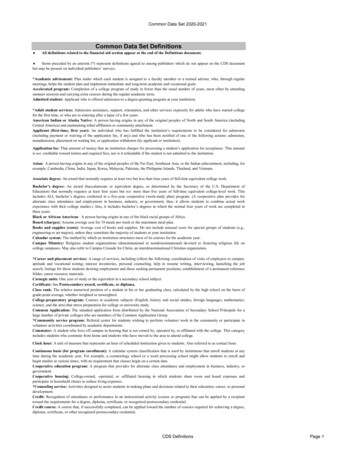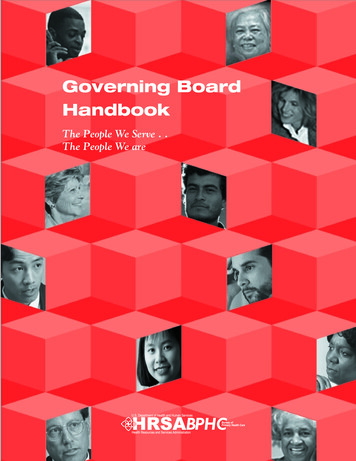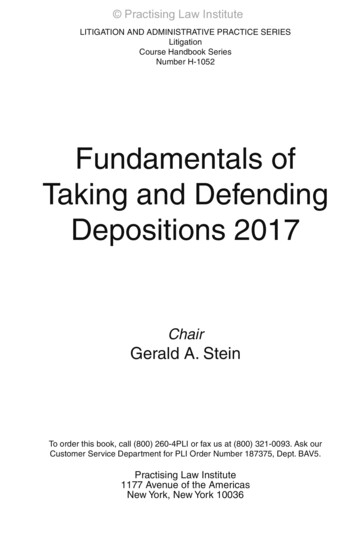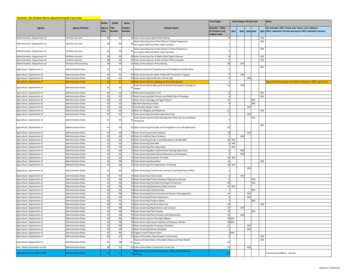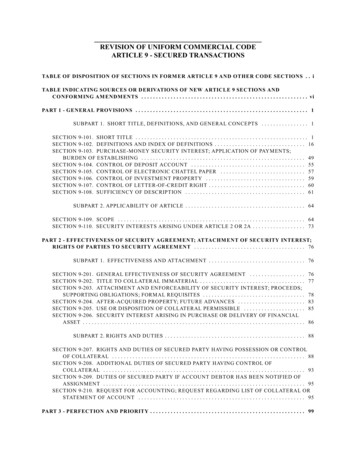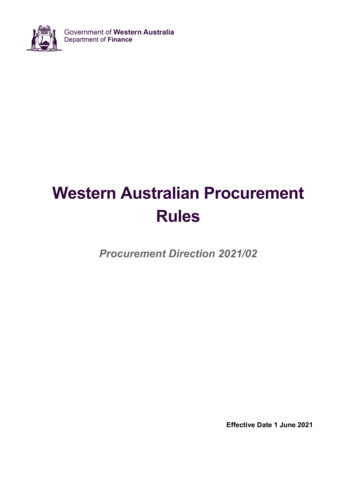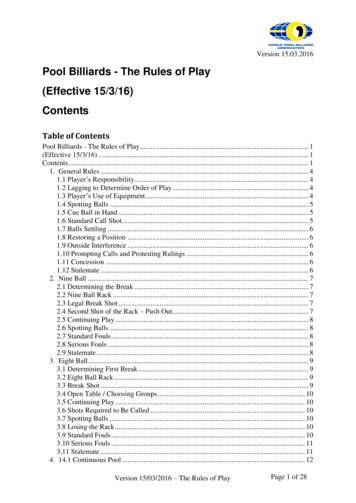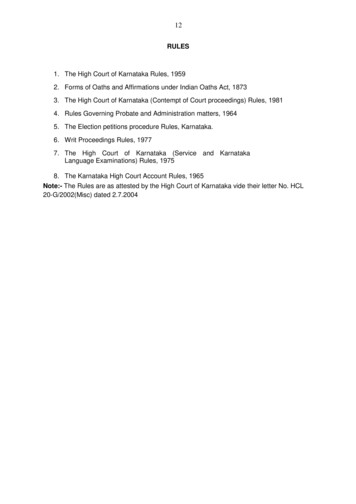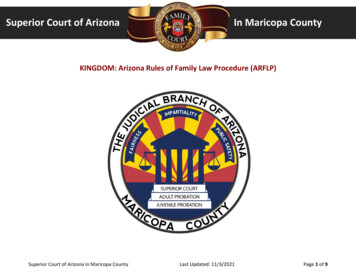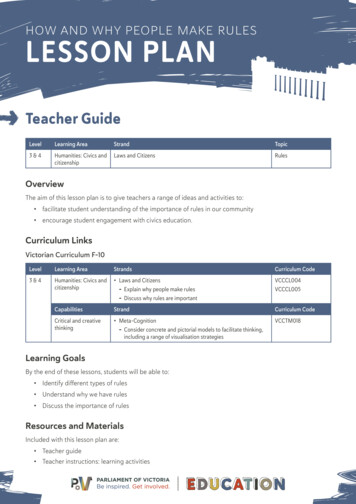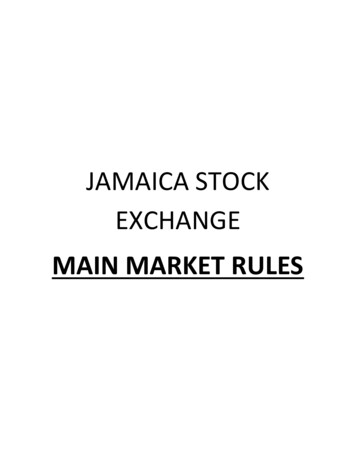
Transcription
GENERAL RULES and DEFINITIONS GOVERNING CERTIFICATIONEVIDENCE DETECTION DOG (EDD)This certification test will consist of the following:1. Obedience – To show the extent of control by the handler at heel and at a distance.2. Searching – To locate, indicate and/or retrieve articles containing the scent of a stranger.This regional certification may be held separately or in conjunction with a PDI certification. If theEvidence Detector Dog (EDD) certification test is ran in conjunction with a PDI certification, thehandler must declare which certification the team is trying to attain before the start of thecertification. EDD Certification will not be a part of a National Field Trial. Regional Trials only.GENERAL RULES AND DEFINITIONSThese general rules and guidelines will govern testing unless specifically stated otherwise herein.Rules may be discussed for clarification prior to certification, but no changes will be made prior to thetest. All certifications are good through December 31st of the following year. (ie: if you certify onApril 1st, 2022, your certification will not expire until December 31st, 2023) If there is adiscrepancy between the printed version of the rules and the on-line rules, the on-line rules are tobe considered the correct and accurate version. The USPCA, Inc. encourages its regions to offer anannual certification for their members and encourages each member to certify on an annual basis.The regional executive board shall approve all certifications held within their regions.1. ASSOCIATION: The term “association” when used in the context of these regulations shallrefer to the rules committee, the judges committee or the National USPCA Executive Committee.2. INDIVIDUAL ENTRIES:A. Each handler must be a member of the USPCA and a full-time paid law enforcement officerof a city, town, county, state or federal agency. The handler must also be a working K-9 officerassigned to a K-9 and duties appropriate to it. Any member who has retired in good standing with aminimum of 10 consecutive years as a member of the USPCA may also certify their trained K-9 if theyare working in a part time status for a law enforcement agency and are assigned K-9 duties. Thiswould also apply to any full retired member who is a reserve, special deputy or any status where themember is still recognized as a law enforcement officer. The member must maintain continuousmembership with the USPCA upon retirement. If their membership is not continuous, they will not beeligible to certify their K-9.B. A special member as defined in the By-laws may certify a dog in a regional EDD trial if approvedas a special member by their region. (Approved 9-16-18 in Huntsville)C. Certifications will not be permitted for the purpose of marketing or selling dogs.1
D. Testing order will be drawn prior to the test and is at the Chief Judges’ discretion, as is schedulingof participants at each location or venue.3. TEAM ENTRIES:See team entry information from the General Rules and Definitions under the Patrol Dog Icertification. EDD certification will not be a part of the National Field Trials. Regional Certificationonly.4. JUDGES AND JUDGING:See General Rules and Guidelines under Patrol Dog I Certification.5. STEWARDS – OPTIONAL:See General Rules and Guidelines under Patrol Dog I Certification.6. TEST REQUIREMENTS:A. A qualifying score of 70% is required in obedience and in article/evidence search forcertification as an EDD.A team scoring less than 70% in either phase will be allowed tocontinue in the certification for experience only at the direction of the Chief Judge. 70% inobedience is 84 points. 70% in article/evidence search is 49 points.B. During testing, handlers will not carry any leashes or paraphernalia that would indicate an attemptto control or influence the dog. No whistles, ultrasonic devices or related aides not specifically statedherein will be allowed. All these devices must be left in the parking area. Spike or pinch collars arepermitted. A dummy collar or non-operational electronic collar shall be allowed. Prior to entering thetesting field, a field steward will check the K9’s E-Collar to ensure that the devise is a dummy collaror that it is shut off. The competitor will also hand the remote to the steward prior to the exercise.C. All handlers will be tested in their standard department duty uniform, with the exception of footapparel or any equipment that will conflict with Rule 5B. Baseball hats may be worn as long as theyare professional in appearance. Numbered vests may be provided for ease of identification and arerequired when provided.D. The collar(s) used on the K-9 during the obedience phase will be used for all other phases. Noadditions, deletions or modification of collars. A team, upon entering the obedience phase, willhave both themselves and their K-9’s equipment checked and listed. The equipment will then bechecked before each subsequent phase and must be the same for each event.E. All phases of the test will be conducted off leash and all handlers will do all exercises with bothhands at a normal side position.F. Protests: The committee ruling on protests shall consist of three or more odd number membersas selected by the Chief Judge. Handlers will advise the steward at the time of occurrence orimmediately after the test or phase, that a protest will be entered or lodged. The steward will notethe protest and scoresheets will be marked that a possible protest may be filed. All formal protestsmust be lodged in writing to the Association (Chief Judge), identified by the teams number only (noname) before they will be considered.2
G. No dog will be left unattended at any time in such a manner as to create a danger or hazard toany other dog, person or itself.H. Each handler will be responsible for any damage done by his or her K-9.I. There will be no aggressive training or practice in areas of testing where it may disturb the normaltranquility of fellow handlers or persons not involved with or participating in the certification.J. Any extrem e or abusive correction or treatm ent of a dog—loss of tem per or display ofpoor sportsm anship w ill result in disqualification from the certification trial. TheExecutive Board may undertake its own investigation and take any action it deems appropriate basedon the totality of the circumstances.7. HANDLERS PREPARATION:A. There will be no lengthy explanation of the exercise while on the field. It is the handler’sresponsibility to know what he or she has to do on each exercise.B. A handler, who is familiar with these rules, should be able to enter the test area under any judgewithout having to inquire as to how the particular judge wishes to have the exercise performed andwithout being confronted with some unexpected requirement.C. All teams will start and end each test from a finish position.Teams failing to successfully certify will not immediately be given a second chance. Multiple tests of the sameteam will not be conducted. The team has to undergo a period of retraining, documenting successfulperformance, before any attempt at re-certification. Only official Certificates of Certification (Provided by theNational Office) will be issued to participants who successfully pass a USPCA Certification test.8. DEFINITIONS: Command—One word or signal to achieve or halt a maneuver. The dog’s name when usedin conjunction with a command will also be considered a command (i.e., “Fritz come”—will bescored as two commands).Signal—A single gesture of any part of any limb, which will be returned to the normal positionimmediately. One signal to achieve or halt a maneuver. (Extra body movements will bepenalized).Voice Command—One word to achieve or halt a maneuver. NOTE: Definition- DoubleCommand - a combination of a voice command and a signal command is a double commandand will be penalized.Heel Position—Heeling on the right or left side shall be handler’s choice. However, they mustheel their dogs throughout the entire tests on the same side in which they started theirobedience phase. For explanation purposes, the left side heel will be described. Whether thedog is heeling, sitting, standing or moving, at heel means—the dog shall be straight in line3
with the direction in which the handler is facing at the handler’s left side and as close to theleft leg as is practical without crowding and permitting freedom of movement at all times. Thearea from the dog’s head to shoulders shall be in line with the handler’s left hip. When thehandler and K-9 come to a halt position, or when the dog is called to a heel while the handleris stationary, the dog should come to a finish position as described—without further command.Finish Position—The dog shall assume the finish, which could be either a sit or downposition, with the dog’s head to shoulders in line with the handler’s left hip. The dog will befacing parallel with the handler. The dog will come to this position upon a single command torecall or whenever the handler comes to a halt while the dog is heeling. Whenever executing acommand from the finish position—a command may be given (i.e., “stay” or “heel”).Normal Pace—A brisk even gait.Fast Pace—Handler and dog moving forward together at a noticeably accelerated speed.Slow Pace—Handler and dog moving forward together at a noticeably decreased gait fromthat of normal.9. MISCELLANEOUS:A. Any K-9 relieving itself in the working areas during testing will be penalized once for 10 points inthat phase. Multiple incidents will be penalized 1 2 to 2 points as minor deductions off of work points.B. There will be no consuming of alcoholic beverages on or in the area of the testing sites duringtesting hours by judges, handlers or participating officials.C. All score sheets will be mailed or given to participants after the trials.10. PROFESSIONALISM—CERTIFICATION:A. This is a certification test, not a competition, scored under artificial conditions with equaldifficulty for each team. The purpose is for certification and training. Points are awardedand reflect a scale of performance on the exercises. Lower scores encourage improvementof training methods and ideas. It is the sharing of those methods and ideas that create continualimprovement of the canine team’s performance.OBEDIENCE TESTTEST PHASESA. The complete obedience phase will be done at the direction of a steward who will direct themaneuvers in a military manner. This obedience exercise will not necessarily be done in the beloworder. The Association prior to the commencement of the exercise will select the order. Order ofheeling phase will not be drawn but determined by the Chief Judge.B. Handlers will start and end each phase from a finish position.C. The complete exercise will be done off leash. Leashes (see event rules) and other restrictedparaphernalia will be left with the steward or a judge.Handlers and dogs will be tested in the following maneuvers:4
1. Heeling phase will consist of normal, slow and fast paces, left, right and about turns. Theheeling phase will be no less than seventy-five feet or more than 100 feet for each leg, With theexception of heeling fast and heeling slow, all phases will be done at a normal pace.2. Distance control will be done with the handler fifty feet (marked) in front of his or herdog and will include one “sit” and one “down” by hand command and one “sit” and one “down” byvoice command. The Association prior to the start of testing shall select the order of commands.Handlers will be allowed one command for each of the above. If the dog fails the command, he willlose those points, but will not be assessed points for extra commands to achieve the desired position.The handler may return to the dog to position it, if necessary to complete the phase, and will not bepenalized for doing so. In distance control the judging starts when the handler leaves the dog.NOTE: The steward(s) shall position themselves so as not to be behind the dog at any time.3. Obedience Recall: This will consist of calling the dog from a distance of fifty feet(marked) and stopping the dog at a distance of twenty-five feet (marked) with a sit, down or standcommand. The Association prior to the start of testing shall select the command and maneuver. Thedog shall then be called to a finish position with a voice command.4. Walking Control: Handlers will walk their dogs at a heel position. They will down, sit andstand their dogs at a position determined by the steward. At another point determined by thesteward, the handler will return to and heel the dog without breaking stride or pass their dog makingan about turn at the direction of the steward and pick their dog up without breaking stride. One ofthe three will be a pass by determined by the Association. All commands for this exercise will be byvoice command only.D. If the steward or the Association does not specify a command, it becomes the handler’s choice.E. Handlers may not praise or intentionally touch their dogs during the tests. The steward will advisethe handler when to praise their K-9 (i.e., “Exercise finished”)F. This entire exercise will be done without interruptions.G. Each handler will have the same identical exercises.H. Check sample score sheets for areas of penalties.I. The three Obedience phases will not be intermixed.ARTICLE/EVIDENCE TEST:A. Articles will be supplied by the host city or region/district.B. The Chief Judge or designee for the test will select two of the following articles.1. Expended shotgun shell (dark in color)2. Key on a ring with tab3. Book of paper matches (dark in color)4. Metal gun (if available)5. Plastic credit card or card of equal size and material (dark in color)6. Screwdriver—four to six inches long7. Piece of leather—one-eighth to one-fourth inch thick, three inches by threeinches (dark in color)C. Articles will be tossed into the search area after being scented for a minimum of thirty seconds ina clenched fist by only one judge or steward.D. Two new or unused articles of the same type will be used for each participant.E. The dog will be required to search, find and retrieve or indicate the two selected articles within adefined area. See below for the two listed options. (Teams will have a choice of two options in the5
indication of articles. The same option must be used for both articles. The handler will inform thesteward / judge as to which option they will use prior to the start of this phase)F. The search area will be thirty feet by thirty feet of raised grass approximately twelve inches high.G. The number of search areas will be as many as possible and practical—to be determined by thehost city.H. There will be a three-minute time limit for the total exercise with a thirty-second warning at thetwo-and-one-half (2.5) minute mark for each participant. Time will begin when the handler sendstheir dog.I. Handler will start his dog from a finish position and will secure their lead on their person beforecommencing the exercise. They will not reattach the lead to the dog until completion of the search.J. The handler may start from anywhere around the perimeter. The time will start when the handlersends their dog. If the handler chooses to walk the perimeter prior to starting the exercise, time willbegin as the team crosses the point at which they started. The handler will not enter the search areaexcept as defined for Option Two, the passive indication.K. The dog will be judged on the indication and alert on the article. This must be obvious to thejudge.L. The evidence search must be done in a lighted area with article made safe for the protection ofthe dog and the handler.OPTIONS:Option One – RETRIEVEUpon finding the article, the dog will retrieve the article and return it to the handler, holding the article untilcommanded to release it in hand. The handler must remain in a stationary, upright position. The dog willbe sent to find the second article. Finding the second article, the dog will return it to the handler, andagain, hold it until commanded to release it in hand. After releasing the second article, the dog will becommanded to a finish position. Unnecessary movement on the part of the handler will be penalized.The handler may not enter the search area. If the K-9 indicates on an article but does not retrieve it, ajudge or handler may retrieve the article. (This is for points on the find for the benefit of the handler)Option Two - PASSIVEUpon finding the article, the dog will give a passive indication of the article, remaining stationary in a sit,down or stand close to the article but without touching or disturbing the article. The handler will tell thejudges that his dog has indicated and walk directly to the dog, picking up the article and showing it to thejudges. During this time the dog must remain in the original indication position. The handler will then returnto the perimeter of the area by the shortest route. The handler may command his dog to heel, or leave thedog in the area. Once the handler is out of the area, he will command the dog to search for the secondarticle. When the dog indicates the second article, the handler will tell the judges that his dog has indicated,enter the area, pick up the article and show it to the judges. During this time the dog must remain in hisindication position. The handler will return to the perimeter and bring his dog to a finish position. Thehandler may not enter the search area until his dog has indicated and the handler notifies the judges that hisdog has indicated.6
Chief Judges are responsible for the accuracy and completeness of the paperwork.Upload completed trial program or paperwork to include: (within 30 days of the trial) Original Master score sheet Judges and Scorekeepers list with events judged The high-low sheets showing the scores of all judges.Questions? Contact National Secretary Melinda RuoppE-mail to: uspcasec@heartofiowa.net20227
testing field, a field steward will check the K9's E -Collar to ensure that the devise is a dummy collar or that it is shut off. The competitor will also hand the remote to the steward prior to the exercise. C. All handlers will be tested in their standard department duty uniform, with the exception of foot
